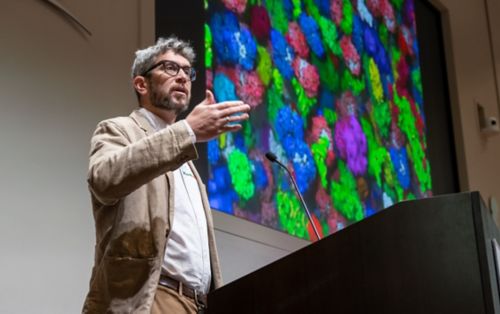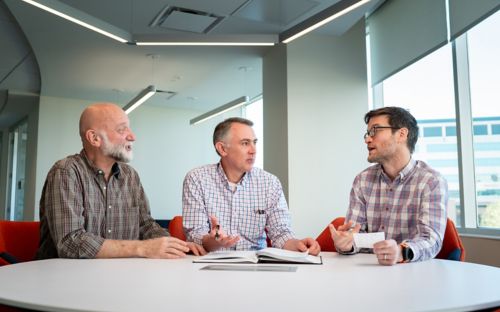St. Jude Research Collaboratives program reaches across institutional boundaries to multiply impact

Clifford Brangwynne, PhD, Princeton University, discussing biomolecular condensates at the Joint Meeting of the St. Jude Research Collaboratives.
Collaboration is one of the best tools a scientist has. The melding of ideas, skillsets, resources and experience often produces a synergistic effect, leading to impactful results greater than what individual groups may accomplish alone. Through collaboration, scientists capitalize on their varying perspectives to drive innovation, which, at St. Jude, translates into cutting-edge discoveries and potential cures for catastrophic childhood cancers and other diseases.
At St. Jude, researchers understand the power of collaboration. In 2017, the institution launched the St. Jude Research Collaboratives Program. This program encourages collaboration between St. Jude researchers and innovative scientists at other institutions. But it does so in a unique way: St. Jude provides funds to all the investigators in the collaboratives, including those at outside institutions. In doing so, St. Jude is tearing down some of the barriers that can stall breakthroughs.
“Innovation is born from interaction and collaboration,” said Charles W. M. Roberts, MD, PhD, St. Jude Comprehensive Cancer Center director and Executive Vice President. The Comprehensive Cancer Center facilitated the development of and oversees the Collaboratives program. “While it is perhaps unprecedented for one research institution to fund investigators at another, we saw an opportunity to bring together some of the world’s greatest minds, regardless of institution, to address pressing challenges in pediatric catastrophic disease. And the early impact has been impressive.”
How it works
Launching a collaborative requires a St. Jude principal investigator (PI) to assemble a team of other St. Jude scientists and leading scientists from other institutions. The goal? Pool their collective knowledge, experience and resources to advance our understanding of complex pediatric diseases.
A proposal for the scope of the collaborative’s work is submitted by the St. Jude PI and reviewed by senior St. Jude faculty. The most impactful proposals, centered on top priority areas, are provided with research support for five years, representing several million dollars for each team.
Five proposals have been chosen thus far, and more are on the way. The subject matter of the funded proposals is as varied as the expertise of the teams assembled. From cancer epigenetics and fundamental cell biology to gene therapy for sickle cell disease and implementation science, each collaborative boasts an impressive record, with three programs recently being renewed for an additional five years.
Biomolecular Condensates
St. Jude established the Collaborative on Membrane-less Organelles in Health and Disease (recently renewed as the Collaborative Research Consortium on the Biology and Biophysics of RNP Granules) to investigate biomolecular condensates.
Biomolecular condensates are organelles with no membrane. Yet, they gather molecular components in the same physical space, which can activate important biological processes. Researchers at St. Jude are working to understand their formation and functions at a molecular level.
After many successes in the first funding period of the collaborative, the Biomolecular Condensates project was renewed with a focus on condensates called ribonucleoprotein (RNP) granules, which are involved in memory, development and disease. Aberrant RNP granules can cause neurodegeneration and cancers, so understanding them at a fundamental level directly impacts human health.
“The field has moved quickly over the last 10 years, and St. Jude scientists and our partners within the collaborative are recognized as key players in this advancement. We have taken major steps towards understanding the molecular basis of healthy and disease states [of condensates], and this is the basis for developing therapeutics rationally,” says collaborative leader Tanja Mittag, PhD, St. Jude Department of Structural Biology.
Mittag credits the success of the collaborative to the assembly of an experientially diverse team with similar scientific interests. “Given that there is a high amount of shared interest but little overlap in core expertise, this has been a very rewarding model for collaboration. This is truly a case of the whole being more than the sum of the individual parts.”
The collaborative on RNP granules comprises investigators from St. Jude, the University at Buffalo, Princeton University and Washington University McKelvey School of Engineering in St. Louis. Within the first five years, investigators have developed new methodologies to study condensates at micro- and macroscopic scales and made several integral discoveries pertaining to their roles in biology and disease, resulting in over 70 publications in high-impact journals.
This collaborative was renewed in 2022, and proposed projects will explore the structure and dynamics of condensates and how they relate to biological functions and pathology-associated dysfunction.
Sickle Cell Disease
St. Jude established the Collaborative Research Consortium for Sickle Cell Disease to advance treatments for this devastating genetic disease. Sickle cell disease (SCD) is an inherited red blood cell disorder affecting more than 100,000 Americans and millions worldwide.
Great strides have been made in managing SCD. But for many, the disease wreaks havoc on organs and causes major medical complications and even early death. This is where the SCD consortium steps in — to develop novel SCD treatments that can be administered before organ damage occurs.
Led by Mitchell J. Weiss, MD, PhD, St. Jude Department of Hematology chair, the collaborative seeks to develop new treatments by harnessing the power of fetal hemoglobin (HbF) induction in SCD-patient red blood cells and developing genome editing strategies.
“Our efforts have brought cutting-edge genetic technologies toward developing new therapies for sickle cell disease, either by altering the disease-causing mutation or inducing fetal hemoglobin,” said Weiss. “We have also garnered new insights into the biology of red blood cell production and the mechanisms of hemoglobin gene expression.
Regarding the Research Collaboratives program, Weiss states, “Among academic institutions, St. Jude is uniquely positioned to offer this funding mechanism. [The collaborative] brings the most talented investigators together to brainstorm and synergize research to generate new knowledge. I am proud that our accomplishments will likely produce new therapies that will improve the lives of patients with sickle cell disease.”
The team comprises scientists from St. Jude, Boston Children’s Hospital/Harvard Medical School, Children’s Hospital of Philadelphia, the Perelman School of Medicine at the University of Pennsylvania, the Broad Institute of MIT and Harvard and the Division of Intramural Research of the National Heart, Lung and Blood Institute at the NIH.
Collectively, these researchers have published over 40 peer-reviewed manuscripts and generated data supporting two clinical trials set to open in 2023 at St. Jude and Boston Children’s Hospital. Over the next five years, the SCD collaborative will continue building on their current discoveries and optimizing the next generation of genome-editing strategies.
Chromatin Regulation
Many cancers diagnosed early in life result from normal development going awry. The Chromatin Regulation in Pediatric Cancer Collaborative was launched to identify the mechanistic origins of pediatric cancers with the hope that such insights may ultimately lead to new therapies. The collaborative is deep diving into how chromatin, an essential DNA packing structure, is regulated and what happens when this regulation goes off-track. Scientists are gleaning important information about cancer development and progression through understanding these disruptions.
Led by Paul Northcott, PhD, St. Jude Department of Developmental Neurobiology, the Chromatin Collaborative has made integral advances in what is known about brain tumors and blood cancers. Scientists have provided experimental data that has shaped the design and implementation of personalized therapy for children with medulloblastoma and identified novel subtypes of leukemias. Their work has also led to the development of several potential therapeutics for rhabdoid tumors and tumors in the central nervous system, kidneys and soft tissues. Some of these therapeutics have already progressed to clinical trials and clinical partnerships with other institutions such as the Children’s Oncology Group and the German Cancer Research Institute (DKFZ).
This collaborative includes investigators from St. Jude, Dana Farber Cancer Institute, the Broad Institute of MIT and Harvard and Washington University School of Medicine. In the first five years, these researchers collectively published over 90 manuscripts in peer-reviewed journals.
When speaking on the benefits of the team structure, Northcott said, “Through the collaborative, we have been able to openly exchange technology, datasets, pipelines and intellectual concepts that have been rewarding for all participants. We are connecting trainees and scientists from diverse training backgrounds with complementary skillsets that would otherwise be unlikely to cross paths.”
The Chromatin Collaborative was renewed in 2022 and will continue to study chromatin regulation to improve treatment opportunities and quality of life for children with difficult-to-treat cancers.
As for what is to come, Northcott said, “Now in our second phase of the Chromatin Collaborative, we have brought together expertise across some of the most aggressive and clinically challenging childhood cancers with leaders in functional genomics, proteomics and computational biology to execute genuinely interactive and impactful science.”
Collaboration at its finest
St. Jude is reimagining collaboration at the institutional level, and so far, it has paid off. With a track record of success, St. Jude aims to expand the program. The first three funded projects have been renewed and will continue, and other funded collaboratives in the program are rapidly working to make new advances. St. Jude plans to add additional collaboratives to the program in the future. The investment in the St. Jude Research Collaboratives Program speaks to the institution’s financial commitment to collaboratively find answers to the most challenging questions in biomedical science.






